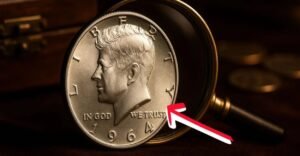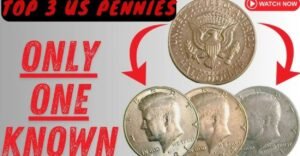Imagine reaching into your pocket for a forgotten coin and pulling out a small, reddish-brown penny that could change your life forever. That’s the magic of the Lincoln Wheat Penny—a humble one-cent piece from over a century ago that’s mostly worth just its face value. But hidden among billions minted, a handful of mistakes turned some into treasures worth half a million dollars.
We’re talking about the famous 1943 Copper Lincoln Wheat Penny, a wartime blunder that’s become a collector’s holy grail. In this eye-opening guide, we’ll uncover the story behind these everyday miracles, spotlight the $500,000 stunner, and share simple ways to spot one in your own stash.
The Roots of the Lincoln Wheat Penny: A Birthday Gift for History
The Lincoln Wheat Penny burst onto the scene in 1909, crafted as a special nod to President Abraham Lincoln’s 100th birthday. Before this, pennies featured a Native American chief’s profile, but folks wanted something fresh to honor the man who kept the nation together during tough times. Enter Victor David Brenner, a talented sculptor who dreamed up a design blending Lincoln’s honest face with symbols of American grit.
On the front, Lincoln stares right with “In God We Trust” arched above and the year stamped below—simple yet striking. Flip it, and you’ll see two tall wheat stalks hugging “One Cent” and “United States of America.” That golden wheat? It stands for growth, farming roots, and the promise of plenty after hard labor. Made mostly from copper (about 95%) with a dash of tin and zinc, these pennies were tough enough for daily pocket jostles.
A Coin Tied to America’s Heartbeat
What makes it special? It’s more than metal—it’s a snapshot of resilience. During shortages, people saved Wheat Pennies like talismans, turning them into family heirlooms. Today, untouched ones gleam like time machines, pulling in hobbyists who chase the stories etched in every ridge.
The $500,000 Marvel: Unraveling the 1943 Copper Penny Mystery
Enter the star of our show: The 1943 Copper Lincoln Wheat Penny, a fluke so wild it could fetch $500,000 at auction in pristine shape. Picture World War II raging—copper was gold for bullets and wires, so the Mint swapped to zinc-coated steel for pennies that year. These turned out gray and clunky, sticking to magnets like fridge notes.
But oops! A batch of old copper blanks slipped into the mix at the Denver or San Francisco plants. Machines stamped them anyway, birthing maybe 20 to 30 copper 1943s—exact count unknown, as many vanished into collections or melts. Spot one? It’s reddish-brown, weighs heavier than steel siblings, and laughs off magnets. The “D” or “S” mark under the date? That cranks rarity higher.
The Hunt That Hooks a Nation
Finding one feels like lightning—rumors swirl of attic jars or beachcomb finds. But fakes abound: Shady folks plate steel pennies in copper. Real deals? They pass pro tests, proving that one slip-up minted millionaires.
Beyond the Big One: Other Wheat Penny Gems to Chase
The 1943 Copper steals headlines, but Wheat Pennies hide more winners. Low-run years like 1909-S (under 500,000 made) or doubled-print flops pack punches too. Here’s a snapshot table of standout varieties and their 2025 values (based on good-to-mint condition; pros grade for precision):
| Variety/Year | Why It’s Rare | Average Value (Circulated) | Auction High (Mint State) |
|---|---|---|---|
| 1943 Copper (D or S) | WWII steel switch error | $100,000+ | $500,000+ |
| 1909-S VDB | First-year with designer’s full initials | $700–$1,500 | $168,000 |
| 1955 Doubled Die | Fuzzy date/letters from misaligned die | $800–$2,000 | $125,000 |
| 1922 Plain (No D) | Missing Denver mint mark | $500–$1,200 | $45,000 |
| 1914-D | Super-low mintage (1.2 million) | $150–$400 | $160,000 |
These show variety’s spice—errors and scarcity turn cents into cash cows.
Quick Spotter’s Guide: Bullet-Point Basics
To play detective with your coins:
- Date Check: Hunt 1909, 1914, 1922, 1943, or 1955 for hot leads.
- Color Clue: Copper shine beats steel gray—test with a fridge magnet.
- Mark Hunt: Tiny “D” or “S” below the date? Jackpot potential.
- Flaw Scan: Blurry text or off-center stamps scream error.
- Wear Watch: Shiny (uncirculated) beats banged-up every time.
Grab a magnifying glass and old jars—fun starts free.
Smart Moves for Aspiring Penny Hunters
Diving in? Start small: Sort family change or hit estate sales. Clean gently with water—no polishes, as shine sells. For suspects, hit grading pros like PCGS or NGC—they slab and certify for $20–$50, boosting resale. Sell via eBay for quick flips or Heritage Auctions for big hauls. Join clubs like the American Numismatic Association for tips and swaps. Remember: Rarity’s king, but joy’s in the journey—most hunts yield stories, not stacks.
Conclusion: Turn Your Spare Change into a Legacy Hunt
The Lincoln Wheat Penny, born in 1909 as a birthday toast to Lincoln, evolved into a treasure trove where a 1943 Copper error hides $500,000 dreams amid wartime steel swaps. From doubled-die quirks to low-mint marvels, these coins prove history’s slips can pay off big—blending nostalgia with numismatic thrill. Whether you’re eyeing that table of values or bullet-testing your stash, the Wheat Penny invites us to look closer at the little things. In 2025’s collector craze, one overlooked cent could rewrite your story. So, raid the piggy bank, learn the signs, and chase the spark—who says fortune can’t start with a penny? Your epic find might just be waiting.
Frequently Asked Questions (FAQ)
What’s the story behind the $500,000 Lincoln Wheat Penny?
It’s the 1943 Copper version—a mint goof during WWII when steel pennies ruled, but copper blanks snuck in. Only a few dozen exist, making top ones auction kings at half a mil.
How do I tell a real 1943 Copper Penny from a fake?
Check for reddish color (not gray), no magnet stick, and the 1943 date. Pros like PCGS verify—fakes often plate steel and fool eyes but not tests.
Are all Lincoln Wheat Pennies valuable?
Nope—most fetch a few cents, but errors like 1955 Doubled Die or 1909-S VDB climb to thousands. Rarity and shine set the stars apart.
Where can I sell a rare Wheat Penny?
Start with local coin shops for quick cash, or grade it via NGC/PCGS then hit eBay/auctions like Heritage for max bucks—always get expert eyes first.
How rare is the 1943 Copper Lincoln Wheat Penny really?
Super scarce—maybe 20-30 known, from accidental strikes at Denver/San Francisco. Each one’s a history nugget, tying coin flips to war efforts.




